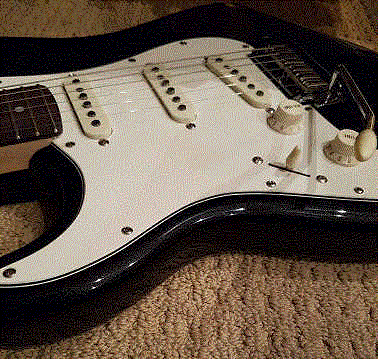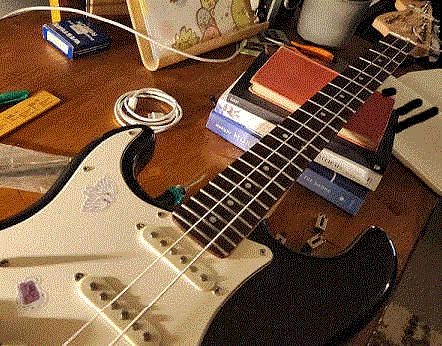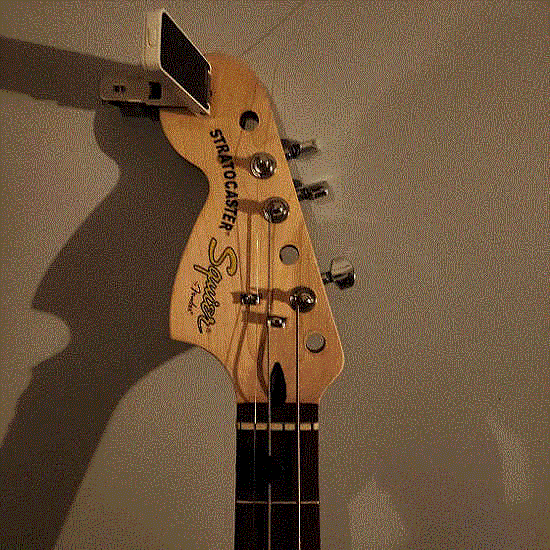basitar, Ramiel, and guitar experimentation
i got my very first electric guitar sometime in, i think, 2017 on my birthday: a cheap, black and white Squier Stratocaster (the only left-handed model in our price-range they had at the time) with a used Line VI Spider amp, i still have both to this day! since then i’ve accumulated a not-insignificant amount of instruments, toys, and other oddities i’ve managed to get my hands on (maybe i’ll write about all of those sometime). but the topic for this particular post are my electric guitars! i’ve gotten two more since then: my trusty Fender Telecaster, tentatively named “Sunny,” and my recent love, my Squier Classic Vibe Mustang “Langley.”

i’ve gotten a lot of use out of those two instruments in the past few years, but every once in a while i feel the weight of my neglect for that very first electric guitar, whom i’ve now named “Ramiel.” admittedly the electronics on it can leave a little to be desired and so i never felt the need to use it for recording since the other two guitars usually suited my purposes a little bit better. but since i had it i felt like i needed to at least try and find a purpose for it; maybe give it some sort of a niche that i don’t currently have filled.
experiment 01: tunings
the first of my experiments with my Squier Strat was trying out some
tuning shenanigans. i had just gotten into Sonic Youth at the time and
figured i had a safe candidate to try out their tunings on. the one i
stuck with for a while was the tuning for my fav
SY song, Schizophrenia:
F#F#GGAA. it has this strange, dissonant, almost ethereal
quality to it that i love. of course, you can’t just tune a regular set
of guitar strings to this—well, i guess you can but you’d lose like half
of your strings lol—so i opted to use the closest gauge counterparts
that i had lying around from a standard set: 2 low Es, 2 As, and 2 Gs
(note that i had to file down the nut slots to do this, so proceed with
caution if you want to try it!). i left it like this for a bit and even
recorded a dark ambient
DREAM DISPHORIA song
with it (esoteric tunings like this are great for stuff like noise,
drone, ambient, etc.!).
one cool unintended thing about the Schizophrenia tuning is
that it’s very close to being an “Ostrich tuning,” or a “trivial
tuning,” one where all the strings are all tuned to the same note. as
much as i liked the dreamy vibe of the Schizophrenia tuning
i found that i couldn’t find that many uses for it, its particular
dissonance was hard to fit into many contexts, and would end up leaving
the guitar untouched for extended periods of time again. eventually
after fiddling around with the strings again i ended up just left it in
a trivial G tuning, GGGggg. as silly as it might look,
giving myself less notes right off the bat made this guitar
more useful to me somehow. i like the way Yvette Young
describes guitar tunings, that they each kind of “colour” the sound in
their own way, in this case i think of it as kind of like a monochrome
palette. i used it to add these super jangly and drone-y overdubs to
some songs by capo-ing at whatever would get me at the song’s key and
just fretting a couple strings at the root notes and letting the rest
ring out. if we’re still using this colour analogy i guess it’d be like
applying a colour filter on top of the song or a blending mode of some
sort.
now, you may have guessed, but Ostrich tuning can be a little bit limiting to say the least lol. while it was fun for a bit to try and work within the boundaries of this tuning, there’s only so much you can do, and i felt like it was making the guitar purely one for overdubs, which can’t be right!
experiment 02: basitar
enter experiment number two! one day i put on a youtube video by David Hilowitz (creator of Decent Sampler!) where he finds and restores a super decrepit guitar and turns it into a “basitar.” he goes into it in the video, but basically, a regular six string electric guitar but with two bass strings instead, used famously by Chris Ballew of the band Presidents of the United States of America. i loved how it sounded and the guitar in the video being a black Strat-style guitar like mine gave me an idea. i stripped off all the strings (insert G-string joke) and took the 2 highest strings off of my bass guitar (the D and G strings). the basitar is a very niche concept, so there isn’t really a lot of information on it or how to set one up. i don’t think anyone really says to use the D and G strings of a bass (instead most people really just said not to do it at all lol), but i approximated it with what i had compared to what i think are the gauges that Ballew of POTUS uses (he might have used baritone strings instead, if i recall).
pretty much every instance i’ve seen of Ballew’s basitar, or other
people’s imitations, had the bass strings being in the A and G string
positions of the guitar, i.e skipping one string in-between. my guess is
that it counteracts the larger thickness of the strings so they wouldn’t
be too close together and more like a bass guitars string distance.
after just slapping the strings onto the guitar i was surprised at how
well it took the much higher gauges. they were pretty much playable
immediately, to a certain extent, and with some simple adjustments it
was a pretty decent playing guitar! or, uh, basitar! the filed-down nut
slots i had already done for the SY tuning were actually already pretty
close to what i needed for these new strings to fit snug. the way bass
strings feel on a standard six string guitar is also surprisingly
different. the shorter scale-length makes frets easier to reach, of
course, but there’s a kind of extra “thumpiness” (?) there that i love
and kind of reminds me of, say, a Fender Mustang bass. the tuning i went
with was DA (half-step higher from what POTUS used) so it
actually occupies the same range as a normal guitar in drop D, but the
bigger string gauges give the sound much more weight and also kind of
counteracts the thinner sounding electronics. i loved how it felt and
sounded and how it was just limiting enough to feel creative in without
being too stifling!

experiment 03: Ramiel
one of the things i like about bass strings is that, to me, it feels a lot easier to tap on them. i guess something about the larger gauges makes them easier to ring out when tapped? and this applies to the basitar as well! but then that got me thinking about twinkly emo and math rock (well, i guess i’m always thinking about twinkly emo and math rock), and then that gave me another idea. what if i add just one more string? a regular unwound guitar string, so i could some interesting juxtaposition between the meaty low bass string sound and also some twinkly high stuff.
so i took an extra high E string i had and strung it in the B position,
right next to the (now) A string. i tried it in the actual high E
position first, and it definitely worked, but i actually preferred the
closer proximity to the A string. since the D and A strings are further
apart, if the high E and A strings are closer you can actually fret both
of them with a barre without touching the low D. and since E and A are a
fifth apart you get a power chord really easily without touching the D
string (and of course, D and A also make a power chord, so there’s two
ways to get two very different sounding power chords here!). i left the
high E string as an E, so now the tuning is: DAe,
coincidentally half of the famous
American Football
tuning: DAEac#e. man, i love emo. at this point was when i
named the guitar “Ramiel” (don’t ask me why, i’m not even entirely sure,
i’m just a loser Evangelion fan lmao).
aftermath!
in effect, i basically took the already niche idea of a basitar and altered it even more to fit my personal needs, and i might be the only person to have tried this particular setup? at least from looking around online, i’m sure somebody out there has to have done something similar.
i’ve always operated under the assumption that when i buy a guitar, or any instrument, it’s mine to keep forever. there’s obviously times where you might need to sell one, but i never really operate under the assumption that i will some day, so i don’t worry about things like how the resell value gets affected by doing X or Y to one. i think you should make your instruments unabashedly yours! cover them in stickers, give them silly names, do all sorts of weird stuff and modifications to them (as long as you know what you’re doing), whatever is gonna connect you to your instrument more and make it easier to express yourself on them!

this was fun to do and write about! i might get into my other instruments some day, maybe one on my Squier Mustang and the process of turning it from right to left-handed?